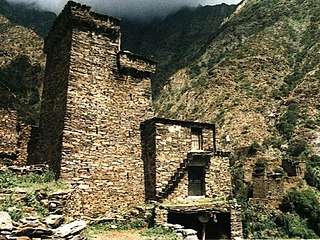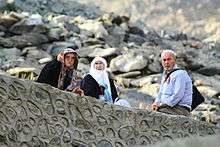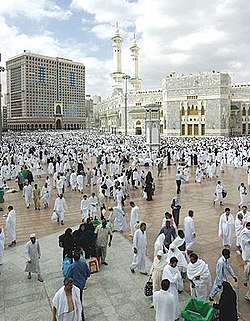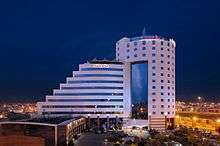Tourism in Saudi Arabia



Although most tourism in Saudi Arabia still largely involves religious pilgrimages, there is growth in the leisure tourism sector. According to the World Bank, approximately 14.3 million people visited Saudi Arabia in 2012, making it the world’s 19th-most-visited country.[1] Potential tourist areas include the Hijaz and Sarawat Mountains, Red Sea diving and a number of ancient ruins.
In December 2013, Saudi Arabia announced its intention to begin issuing tourist visas for the first time in its history. Council of Ministers entrusted the Saudi Commission for Tourism and Antiquities with visa issuing on the basis of certain regulations approved by the Ministries of Interior and Foreign Affairs.[2]
Museums
- National Museum of Saudi Arabia
- The National Heritage and History Museum in Riyadh
- Museum of Buraidah
- Dammam Historical Museum
- Dammam Public Library
- Dhahran Exhibition Center
- Folk Village
- Jeddah Regional Museum of Archaeology and Ethnography in Jeddah
- Nasseef House in Jeddah
- Hejaz Railway Museum in Medina
- Royal Saudi Air Force Museum in Riyadh
- Dammam National Museum is located on the 4th floor of the Dammam Public Library, opposite the Muhammad bin Fahd Stadium on the cross lane from the Dammam-Khobar Highway in Al Toubaishi district. A must for visitors to the region, the museum focuses on the country's history, culture, and inhabitants through displays of relics and remnants of handicrafts.
- Al Ahsa Museum
World Heritage Sites
![]()
![]()
.jpg)
Mada'in Saleh is a pre-Islamic archaeological site located in the Al-Ula sector, within the Al Madinah Region of Saudi Arabia.[3] A majority of the vestiges date from the Nabatean kingdom (1st century AD).[4] The site constitutes the kingdom's southernmost and largest settlement after Petra, its capital.[5][6] Traces of Lihyanite and Roman occupation before and after the Nabatean rule, respectively, can also be found in situ,[6] while accounts from the Qur’an tell of an earlier settlement of the area by the tribe of Thamud in the 3rd millennium BC.[7]
Religious tourism

Tourism in Saudi Arabia still largely involves religious pilgrimages. Mecca receives over three million pilgrims a year during the month of Dhu al-Hijjah in Hajj,[8] and around two million during the month of Ramadan in Umrah.[9] During the rest of the year, Mecca receives around four million for Umrah. The Hajj, or pilgrimage to the city, is one of the five pillars of Islam. However, non-Muslims are not allowed to enter.
Arrivals by country
.jpg)

Most visitors arriving in Saudi Arabia on a short term basis were from the following countries:
| Rank | Country | 2015 | 2016 |
|---|---|---|---|
| 1 | N/A | 3,006,729 | |
| 2 | N/A | 2,878,674 | |
| 3 | N/A | 2,555,000 | |
| 4 | N/A | 2,426,711 | |
| 5 | N/A | 1,800,431 | |
| 6 | N/A | 1,162,955 | |
| 7 | N/A | 999,683 | |
| 8 | N/A | 801,000 | |
| 9 | N/A | 784,502 | |
| 10 | N/A | 500,318 | |
See also
References
- ↑ Tourism in Saudi Arabia: Wish you were here, economist.com.
- ↑ "Tourist visas to be introduced". Retrieved 11 June 2015.
- ↑ Abu-Nasr, Donna (2009-08-30). "Digging up the Saudi past: Some would rather not". Associated Press. Retrieved 2009-09-17.
- ↑ The New Encyclopædia Britannica: Macropædia Volume 13. USA: Encyclopædia Britannica, Inc. 1995. p. 818. ISBN 0-85229-605-3.
- ↑ "Expansion of the Nabataeans". Retrieved 2009-09-17.
- 1 2 "ICOMOS Evaluation of Al-Hijr Archaeological Site (Madâin Sâlih) World Heritage Nomination" (PDF). World Heritage Center. Retrieved 2009-09-16.
- ↑ "Creation of Al-Hijr". Retrieved 2009-09-17.
- ↑ "Hajj Requirements: Visas for 1430 Hajj". Royal Embassy of Saudi Arabia. Archived from the original on 2009-08-11. Retrieved 2009-07-30.
- ↑ "1430H Umrah Visas". Royal Embassy of Saudi Arabia. Archived from the original on 2009-07-26. Retrieved 2009-07-30.
External links
| Wikivoyage has a travel guide for Saudi Arabia. |
